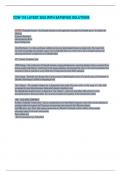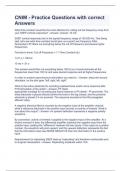The term ‘organisational structure’ describes the way an institution is organised to carry out its objectives and pursue its
projects. In short, organisational structure forms the frame of the organisation’s culture. That is why the structure of an
organisation is used to analyse its culture. Several variables influence the structure of an organisation: size, business
environment and the influence internal and external factors can have on the organisational structure.
Forms of organisational structure:
Generally speaking, two main types of organisational structures can be distinguished: a traditional hierarchical structure
and a structure with several lines of reporting. According to Fatehi (1996): ‘Functions, products and geographic areas
remain the three basic models of organizational structure.’
1. Geographic structure: employees are grouped according to region in the broad sense.
2. Functional structure: responsibilities are arranged according to functional areas. Where a company has several
product lines, the ‘functional managers’ do not always have the same objectives.
3. Product structure: organising staff according to product lines, which are in turn grouped according to product
divisions. Allows a product to be launched simply through the creation of a new division.
4. Mixed structure: preferred by organisations that wish to extend their international business activities. A form that
allows different structures to be combined.
5. Matrix structure: does not respect the principle that each employee has just one superior. Lateral authority. The
two ‘lines’ (functional & project) share responsibility. In general, it facilitates the co-ordination and integration of
projects, but it also has the disadvantage of relying on more managers and of possibly increasing internal competition.
The network structure facilitates partnerships between organisations. Has company units with a horizontal system of
communication. Holden (2002) considers networking as an activity of cross-cultural exchanges of knowledge.
Transnational structure: international enterprises must adopt a multifaceted strategy to respond to the complex
environment. A ‘transnational company’ has the following characteristics:
• It is dispersed, interdependent and specialised.
• National units make differentiated contributions to integrated worldwide operations.
• Knowledge is developed jointly and shared worldwide.
The influence of culture is to be found not only in the choice of structure, but also in the sum of processes occurring
within the organisation. Implies that managers have to adapt their attitudes & skills to their new roles.
Cultural diversity and organisational structure
Adler with Gundersen investigated the impact of national culture and cultural diversity on organisations and the stages
that organisations need to go through before they can call themselves global. One of the key observations they made
was that, in present-day business, ‘firms frequently skip phases in order to more rapidly position themselves to
maximalize their global competitive advantage’. They describe 4 kinds of organisation, each of which is not only an
independent structure, but also one of the phases of development when going global.
1. Domestic structure: Offered their products/services almost exclusively to the domestic market. If they sell their
products abroad, it is because foreign customers want to buy their products. Therefore, they have an ethnocentric
perspective where no sensitivity towards cultural differences is apparent: ‘Worldwide cultural diversity traditionally has
not affected domestic firms’ internal organisational culture’.
2. Multidomestic structure: Organisation is presented as a set of sub-units in several countries which operate
autonomously. Must take into account the particularities of the local market in which it’s operating. Sensitivity towards
cultural differences is therefore important when the implementation of corporate strategy is being considered. ‘Cultural
diversity strongly affects relationships external to the organisation, given that it has both clients and employees in other
countries.’
3. Multinational structure: Geographically spread. Therefore, diversity is inherent. Has an internal organisation
whose culture is affected by the cultural diversity present. That is why these companies attach great importance to
managing multinational diversity within the firm.
4. The transnational (or global) structure: Final type of structure gives enterprises their ‘global’ status. Differs from
others through the fact that it generates its own evolution without having to rely on forces outside the enterprise.
Heterogeneity, and all the problems it may bring, it indispensable. Global strategies of HR become essential and the
diversity present allows mutually beneficial relations to be created.
It must be said that the types of organisational structure given before are based principally on the Western model,
which does not necessarily reflect practices and traditions elsewhere.
, 7.2 Corporate cultures
According to Deal and Kennedy, ‘The business environment is the single greatest influence in shaping a corporate
culture.’ The national cultural setting also has an influence on how companies manage their business.
Corporate culture and management
First, culture is of interest to management if it offers the possibility of increasing efficiency at various levels. Second,
culture helps to understand the organisation as an entity, as a collection of individuals who have together created a
heritage of references based on the experience of the group. Finally, the company has a raison d’être: culture is also a
source of behaviour, and therefore, a source of performance.
Levels of corporate culture
To define ‘corporate culture’, Schein starts with his general definition of culture and its three layers. According to him:
‘The levels of culture go from the very visible to the very tacit and invisible’.
1. Artefacts: everything visible in the organisation: structure, the way offices are arranged, way people dress etc.
2. Espoused values: reveals the strategies, objectives and philosophies of the organisation.
3. Shared tacit assumptions: history of the company, values, beliefs and assumptions of its founder(s) and ‘key
leaders’, as well as certain individuals/small teams that have made the company successful, all these elements form the
culture of an organisation.
In conclusion, Schein insists that cultural assumptions consist not only of the internal workings of a company, but also
above all of how an organisation sees itself in relation to its environment. This forms the culture content of the
organisation, which must:
- Survive in the external environment (mission, strategy, structure, processes …),
- Integrate human aspects (common language, relationships …); and
- Take account of the national culture in which it is operating.
Corporate values
Deal and Kennedy consider that values – which they define as being ‘the basic concepts and beliefs of an organisation’ –
form the basis of corporate culture. ‘Values provide a sense of common direction for all employees and guidelines for
their day-to-day behaviour.’ Three characteristics emphasise values and distinguish companies from each other:
1. The organisations have an explicit philosophy as to why they are conducting business.
2. The management places great importance on communicating the values that shape the company in terms of the
economic choices and the business environment of the company.
3. These values are shared at all levels of the organisation, from the shop floor to the board room.
Identifying corporate cultures: Deal and Kennedy distinguish four categories of culture:
1. The tough-guy, macho culture: takes a lot of risks and quickly finds out whether its actions have been successful.
Puts great emphasis on youth and speed. Decisions must be made quickly, even if there is a risk that they may not be
the right ones. (e.g. police force/hospital). ‘’Find a mountain and climb it’’.
2. Work hard/play hard culture: ‘Fun’ and action culture with a tendency to pursue low-risk activities that give quick
feedback. Feedback is gained rapidly and everyone knows whether or not the work has been carried out according to
the rules. Strict control system preventing big risks. ‘’Find a need and fill it.’’
3. Bet-your-company culture: Favours high risk, but in an environment where feedback is slow. A lot of time passes
before the employees see the benefit of the decisions taken by the company. (high invest in project)
4. The process culture: little feedback and activities are low-risk (banks, insurance companies, financial
departments). Lack of feedback forces employees not to worry about what they are doing but how they are doing it.
Analysing organisation cultures: the ‘cultural web’: The ‘cultural web’, as devised by Johnson et al., is a tool which may
help in the analysis of ‘the behavioural, physical and symbolic manifestations of a culture that inform and are informed
by the taken-for-granted assumptions, or paradigm, of an organisation’.
• Routines & rituals: particular practices which occur as a matter of course in the organisation and which allow it to
run smoothly. Rituals: certain formal events/activities (in-company training courses, afternoon drinks etc.)
• Stories: told by employees to each other or to outsiders
• Symbols: functional purpose but can also carry a meaning about a person’s status or power of individuals.
• Power structures: reflect the importance attached to seniority, length of service and/or expertise.
• Control systems: show how the organisation is being monitored & so emphasise what is considered important.
• Organisational structures: display the hierarchies, both formal/informal, which are used and which identify the
(power) relationships with management.











